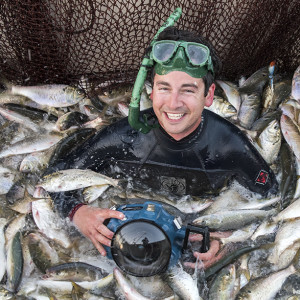Classic hulls keep Chesapeake Bay’s islands connected to the mainland’s live market
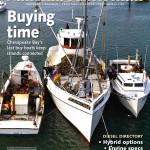
Buy boats were once a common sight in the coastal communities lining the Chesapeake Bay. Up and down the bay, in both Maryland and Virginia, these 40- to 90-foot-long open deck boats purchased oysters on the water from dredgers, hand-tongers and patent-tongers. The buy boats transported the oysters to a processing house where they would be prepared for distribution. The buy boats provided a service to the oystermen by preventing them from having to make a daily trip to the processing house to sell their catch. During the off-season, buy boats were used to haul freight up and down the bay and replenish oyster beds with both shell and seed oysters.
These iconic boats saw their heyday in the first half of the 20th century, before modern highways, bridges and other and transportation conveniences shortened the time required to get oysters to market. The advent of more efficient means of transportation, coupled with the declining oyster populations, put even more stress on the demand for the buy boat service in the latter half of the 20th century. By the 1980s, only a handful of buy boats were buying seafood on the water.
The last stronghold for buy boats on the Chesapeake is on the islands of Smith and Tangier in Maryland. Separated from the mainland by the Tangier Sound and the mainstem of the Chesapeake, these two islands have no means of modern transportation to get seafood to markets on the mainland. The isolation of these islands has kept the bygone days for the buy boat alive.
Four boats earn their keep by purchasing seafood from the watermen of Smith and Tangier and carrying the seafood to both the eastern and the western shores of the bay. Starting in March and April, two crab buy boats — Jill’s Magic and Rippon’s Lady — carry bushels of sooks and jimmies (female and male crabs) north to the processing houses on Hoopers Island.
As the year progresses and the crabbing shuts down in early December, the oyster harvest will make up the haul of the Kaitlin Noelle and the Delvin K. The watermen of both Smith and Tangier depend on the service of the buy boats to get their product to market.
“We have all of the product you want, but we lack quick access to different markets,” says John Tyler, a Smith Island crabber and oysterman.
Delvin K
The 65-foot-long Delvin K is the centerpiece of Tangier Island’s unofficial living history display. Built in 1949 in Bena, Va., a small waterman community on the Guinea Neck, this boat is the last of the authentic buy boats still buying and hauling seafood.
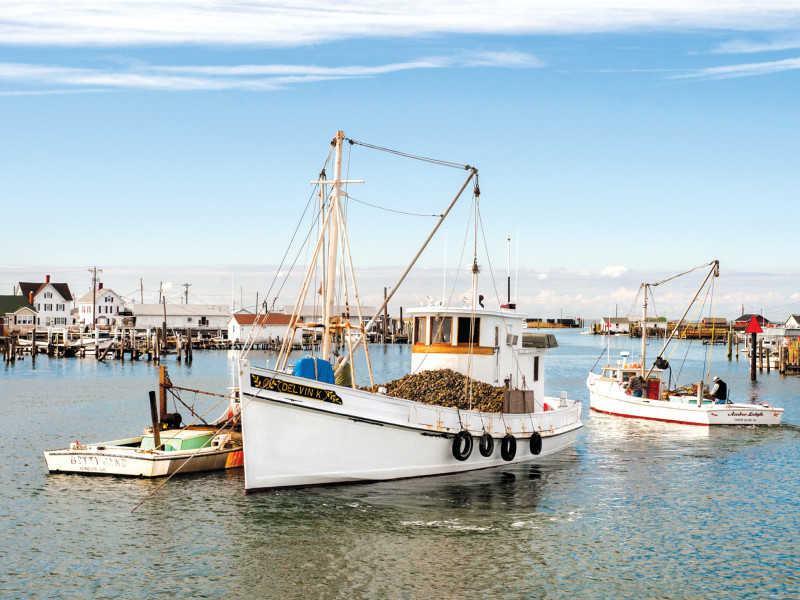
The boat was originally owned and operated by waterman Frank Smith, who worked her near the mouth of the York River, buying oysters and dredging for crabs. In 2004, following a prolific career in boatbuilding, running a railway and harvesting seafood, Tangier Islander Jerry Pruitt purchased the Delvin K and brought her back to Tangier. Pruitt spent the first season he owned the Delvin K repairing old woodwork and “getting her fit to run.”
Pruitt worked on the boat at the Chesapeake Bay Maritime Museum in St. Michaels, Md., with master shipwright Mike Vlahovic and at his railway on the island. Pruitt first put the boat to work during Virginia’s 2005-06 wild oyster season to facilitate the transport of oysters to market from the island.
Pruitt and his crew anchor the boat up in the main channel on Tangier during the mid-morning hours and wait for the dredgers to come in with their catch. The best dredgers will come in ahead of the pack with their limit, and the oysters start dropping on the sheets of stainless steel laid on the Delvin K’s wooden deck.
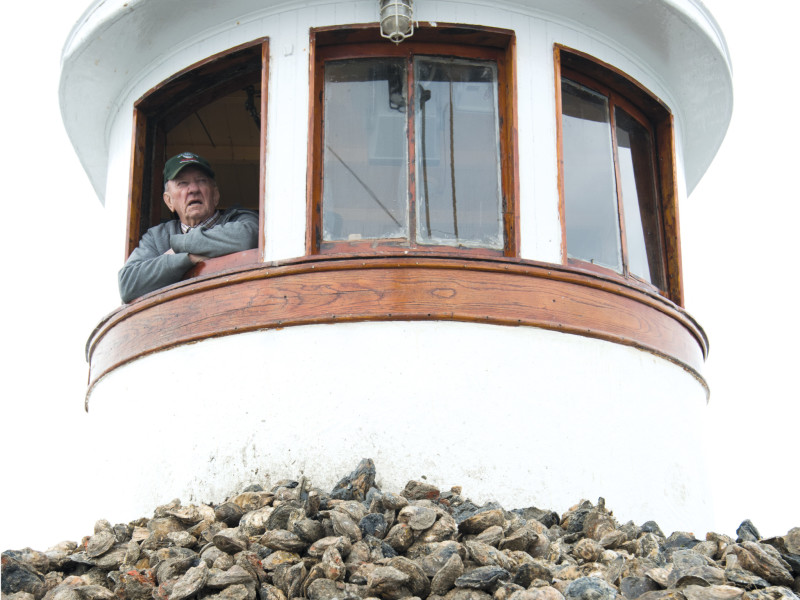
As the morning progresses, the scene on Tangier’s channel mirrors rush hour traffic on the mainland: classic wooden box sterns jockey for a position to tie up abreast to Delvin K. As the oysters are unloaded from the box sterns, a crew member on the Delvin K keeps a detailed tally of how many bushels each boat brings in. On a cam day — island slang for light wind and fair seas — as many as 20 dredgers will sell their oysters to the Delvin K.
Pruitt can carry as many as 400 bushels of live oysters but will make the trip across with as few as 150 bushels. Once every dredger is accounted for, Pruitt and his crew will pull the anchor and run west to Reedville. For making the roughly 12-mile run across the Chesapeake, Pruitt prefers to have a “good load” of oysters on the deck to help stabilize the wooden boat in the event of any weather.
After running up Cockrell’s Creek past the Omega Protein factory, Pruitt ties up the Delvin K to meet a buyer and a crew of able-bodied workers. The shucking house’s workers will unload the catch one shovel load at a time onto a conveyer that delivers the oysters into a refrigerated truck. From here, the haul makes its way to the shucking house, where it’s prepared for distribution to markets throughout the country.
The 2018-19 season will be Pruitt’s 13th year operating the buy boat. And as long as there are enough boats that continue selling to him, Pruitt will continue to run the Delvin K. Pruitt has predicted that this season will be productive for the dredgers working the rocks near the island in Tangier and Pocomoke sounds.
“It seems that the oysters survived well on the rocks that are opening up. But we will know best when they start working,” Pruitt said. He mentioned that the oyster rocks farther up some of the bay’s tributaries — Potomac and Rappahannock — experienced high mortality rates as a result of an overwhelming amount of freshwater runoff from heavy rains in 2018.
Jill’s Magic
Her 50' x 16' aluminum hull does not fit the profile of a traditional Chesapeake buy boat. The Jill’s Magic was built in 1980 by metal fabricators out of Rock Hall, Md., for Lindy’s Seafood to carry weight. Captain Allen “Big Al” Smith has been making the run down to Tangier Island six days a week from April to December to buy crabs for 18 years.
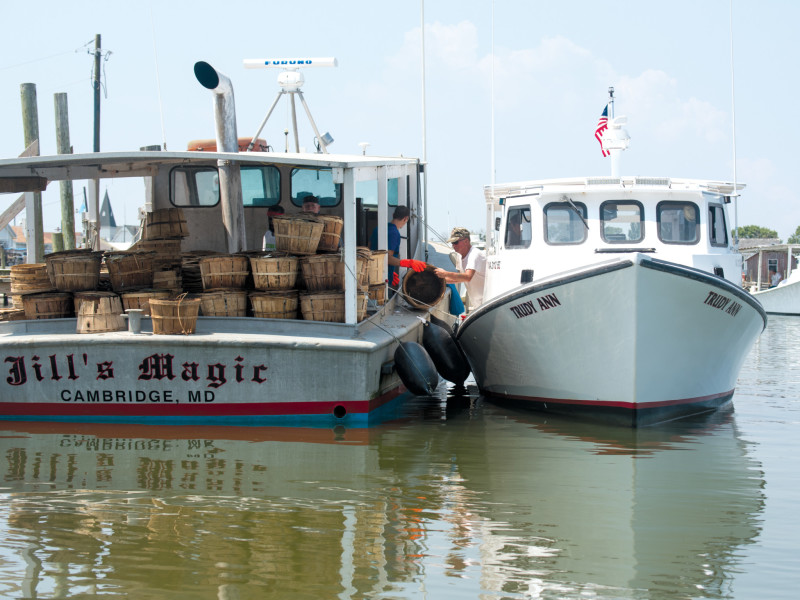
Smith buys from around 25 crab boats up to six days a week. He and his crew tie up to one of the many shanties lining Tangier’s channel and wait for the crabbers to trickle in throughout the late morning and early afternoon. Oversized fenders lining her starboard side allow the crabbers to tie up abreast to Jill’s Magic and unload quickly. The crew on the crab boats create a makeshift assembly line and unload every bushel while the buy boat crew stacks bushel baskets on her metal deck.
Sooks (mature female blue crabs) make up the majority of the Tangiermen’s catch, while jimmy crabs (males) and lemons (egg-bearing sponge crabs) make up the rest of the haul. Lindy’s has the ability to handle all of the catch, whether it’s going to one of their picking houses or to the basket market.
Each fall, from early September to late October, there is a strong push of hungry crabs heading down the bay. Jill’s Magic was built to handle those heavy loads of fall crabs. On the best day of the fall 2018 season, the boat bought nearly 730 bushels from Tangier’s crabbers. With each bushel weighing an average of 46 pounds, that’s a load of approximately 35,000 pounds.
The time it takes for Jill’s Magic to make the nearly 30-mile run back to Hoopersville varies with the amount being carried and the weather. Tangier Sound is a notoriously rough body of water, and the route she takes back home is dictated by the wind direction. Big Al can use Smith, South Marsh and Bloodsworth Islands as a buffer from eastern or western winds while running north to the mouth of the Honga River.
To keep their crabbers happy and the supply chain flowing, Lindy’s does not miss a day of buying on Tangier. When Jill’s Magic is in need of maintenance, the company will call on islanders with able boats to run crabs to Crisfield for them. Don Crockett, Allen Parks, Dan Dise and other watermen on the island have loaded as many bushels as possible into their wooden box sterns for the run across the sound.
Kaitlin Noelle
The Kaitlin Noelle is a 40-foot wooden box stern built in 1975 by the legendary O’Neill Jones of Dorchester County. It is the only boat hauling oysters out of Smith Island, Md.
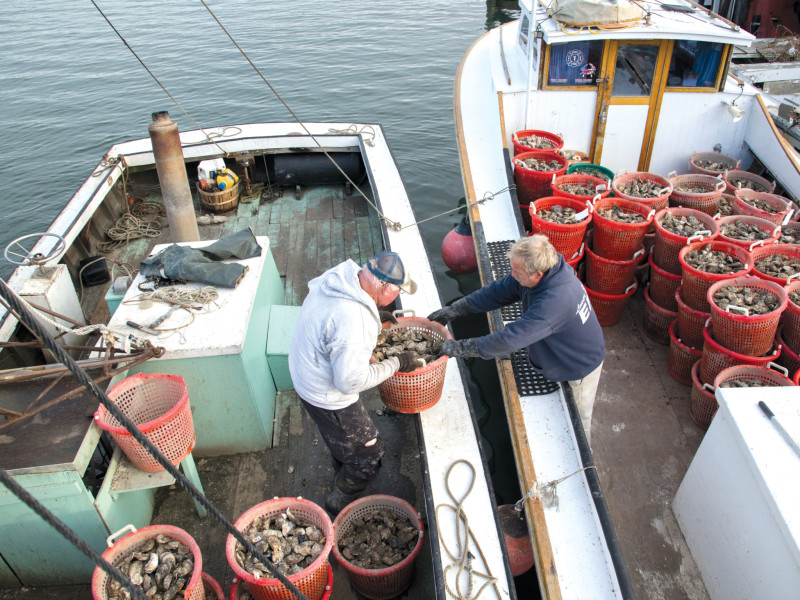
Smith Island oysterman Morris “Goodman” Marsh sells to Eddie Evans on the Kaitlin Noelle. Jay Fleming photo.
The Cajun Queen and the Four Bush were two larger buy boats that most recently hauled oysters to market for the oystermen on the island. However, declining numbers of watermen on the island and the lack of a seed oyster program in Maryland resulted in these larger boats being phased out.
Eddie Evans Jr. got the boat from his son Craig when he got off the water eight years ago. Evans has been using her for hauling oysters from November to March and for crab potting during the spring and summer months.
Evans ties up to his family’s crab house on Levering Creek in Ewell. During the oyster season, when the weather is “fit to work,” Evans will wait for the dredgers to come in and unload. On an average day, he will buy around 140 bushels of oysters from 13 to 15 dredgers. Evans carries the oysters to Crisfield, where laborers from a shucking house meet him and unload the catch.
“I’ve carried more than that across the sound, but I’m not comfortable with it, especially near the Puppy Hole,” said Evans.
Rippon’s Lady
The husband-and-wife team of Clarance Ruark and Janet Rippon operate Rippon’s Seafood, the picking house that buys nearly all of the hard crabs from the watermen working out of Smith Island. Six days a week during the crabbing season, Ruark will haul crabs while Rippon will handle the picking operations, sales and distribution for the business that was started by her family in 1947. Ruark runs the 40-foot Robbins Rippon’s Lady from Hoopersville south to Ewell, the northernmost town on the Smith Island archipelago. The 19-1/2-mile run takes him an hour and 15 minutes under the power of the boat’s 450 Cummins engine. The boat ties up at the Evans’ family crab house, abreast to the Kaitlin Noelle (Smith Island’s oyster buy boat). Ruark buys hard crabs from the crab scrapers, peeler potters and hard crabbers. The soft crabs that leave the island are carried to distributors on the mainland through the island’s ferry system. The biggest haul of hard crabs that Ruark has seen was in the fall, when he carried 388 bushels back to the picking house.
After the crabs are picked and the meat is packed, the iced boxes of crab meat are loaded onto the company’s refrigerated trucks and distributed directly to retailers and restaurants.
Chesapeake Bay history will be kept alive by the isolation of Smith and Tangier islands as long as the residents continue to harvest seafood. The demand for the services of these four boats to get product to market will be driven by the number of watermen working out of the islands.




